Auditing and Assurance in Australia
VerifiedAdded on 2022/10/10
|6
|1813
|111
AI Summary
This document provides advice on two aspects of auditing in Australia: the expectation gap and threat to independence. It also suggests safeguards to reduce these threats to a safe level. The expectation gap refers to the disparity between the public perception about the roles and responsibilities of the auditors regarding audit engagement and what the actual legal roles and responsibilities of the auditors are. Threat to independence is considered as a crucial aspect in the process of financial auditing which demands the auditors to maintain independence from any party having any kind of financial and non-financial interest in the audit client since this can affect the audit result.
Contribute Materials
Your contribution can guide someone’s learning journey. Share your
documents today.
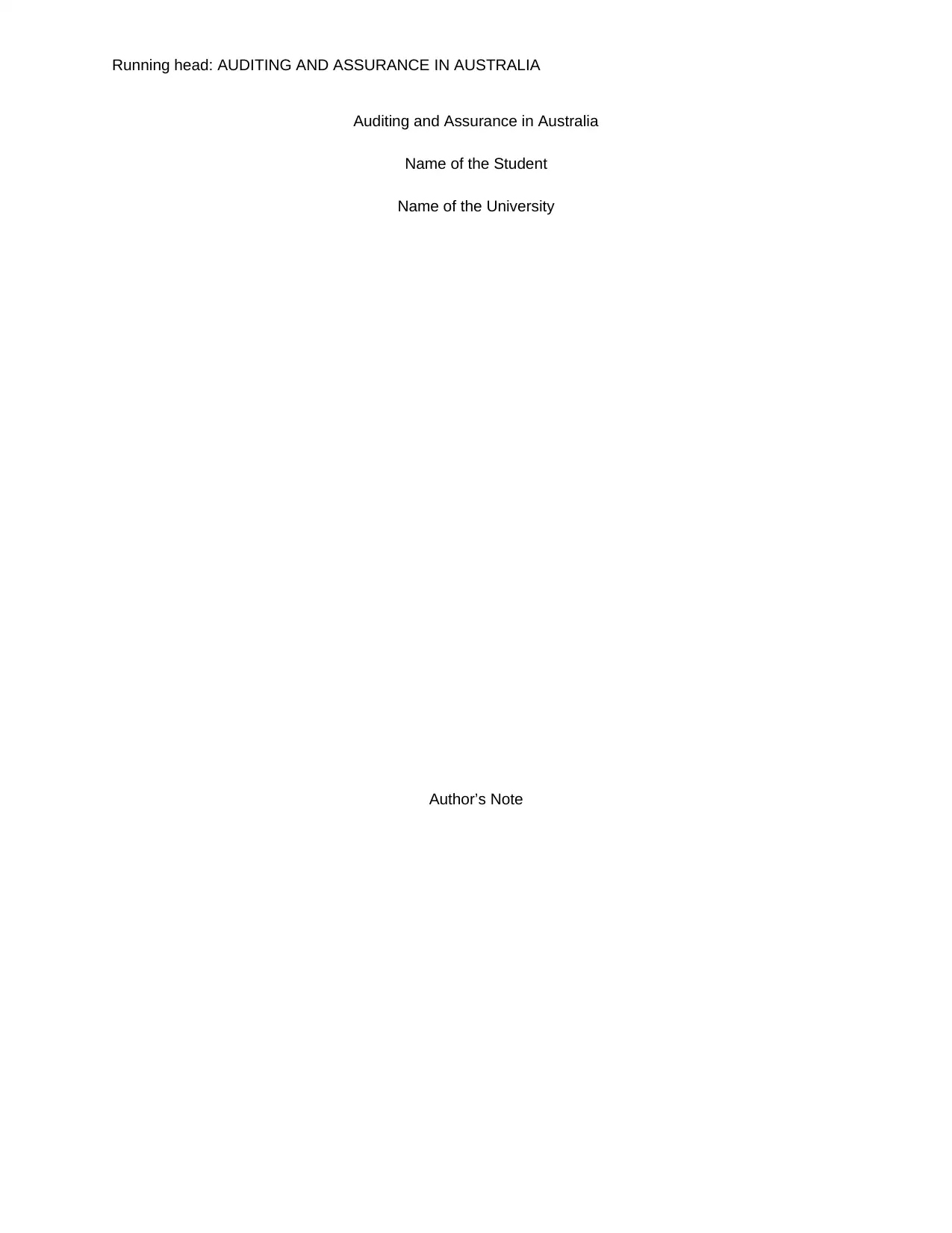
Running head: AUDITING AND ASSURANCE IN AUSTRALIA
Auditing and Assurance in Australia
Name of the Student
Name of the University
Author’s Note
Auditing and Assurance in Australia
Name of the Student
Name of the University
Author’s Note
Secure Best Marks with AI Grader
Need help grading? Try our AI Grader for instant feedback on your assignments.
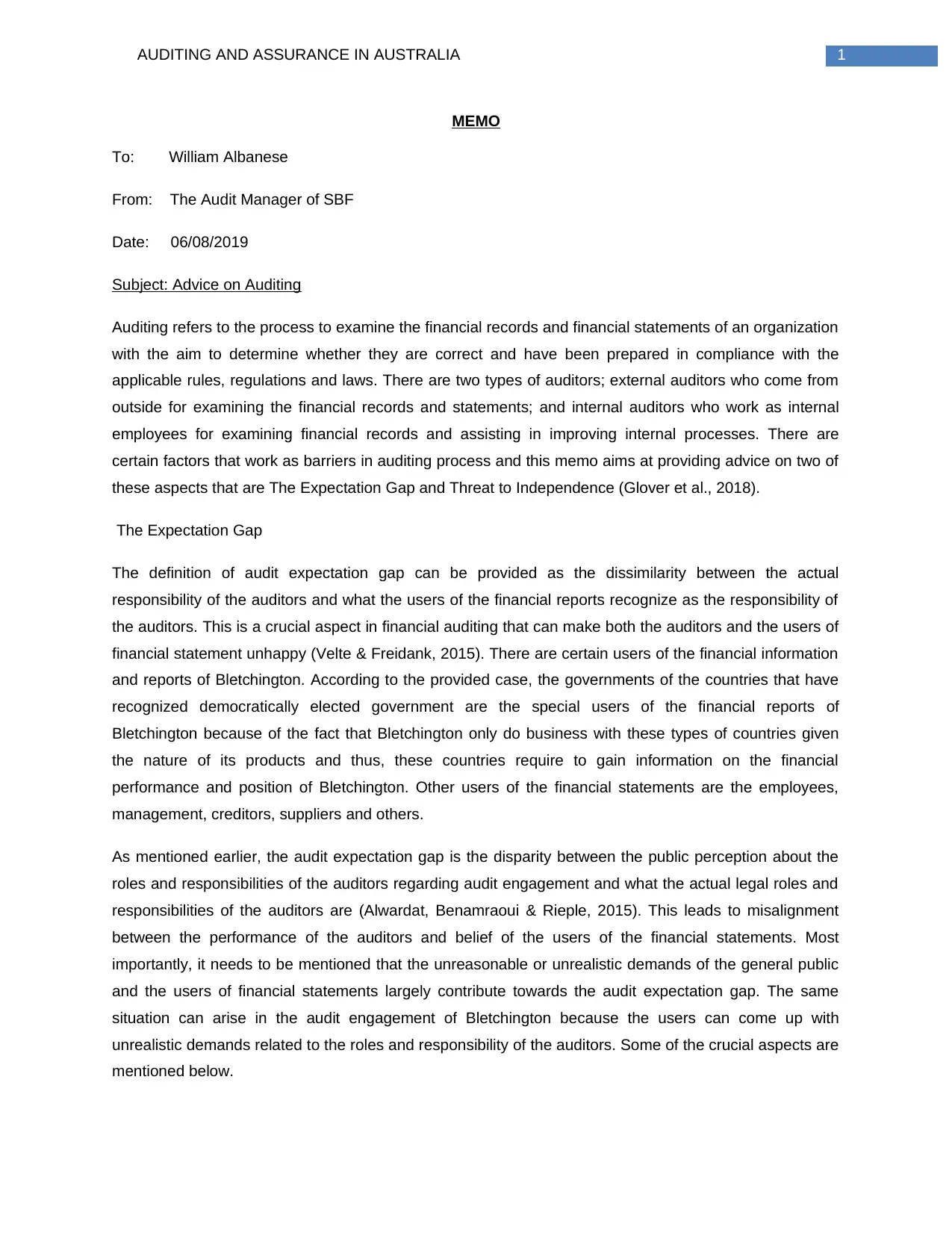
1AUDITING AND ASSURANCE IN AUSTRALIA
MEMO
To: William Albanese
From: The Audit Manager of SBF
Date: 06/08/2019
Subject: Advice on Auditing
Auditing refers to the process to examine the financial records and financial statements of an organization
with the aim to determine whether they are correct and have been prepared in compliance with the
applicable rules, regulations and laws. There are two types of auditors; external auditors who come from
outside for examining the financial records and statements; and internal auditors who work as internal
employees for examining financial records and assisting in improving internal processes. There are
certain factors that work as barriers in auditing process and this memo aims at providing advice on two of
these aspects that are The Expectation Gap and Threat to Independence (Glover et al., 2018).
The Expectation Gap
The definition of audit expectation gap can be provided as the dissimilarity between the actual
responsibility of the auditors and what the users of the financial reports recognize as the responsibility of
the auditors. This is a crucial aspect in financial auditing that can make both the auditors and the users of
financial statement unhappy (Velte & Freidank, 2015). There are certain users of the financial information
and reports of Bletchington. According to the provided case, the governments of the countries that have
recognized democratically elected government are the special users of the financial reports of
Bletchington because of the fact that Bletchington only do business with these types of countries given
the nature of its products and thus, these countries require to gain information on the financial
performance and position of Bletchington. Other users of the financial statements are the employees,
management, creditors, suppliers and others.
As mentioned earlier, the audit expectation gap is the disparity between the public perception about the
roles and responsibilities of the auditors regarding audit engagement and what the actual legal roles and
responsibilities of the auditors are (Alwardat, Benamraoui & Rieple, 2015). This leads to misalignment
between the performance of the auditors and belief of the users of the financial statements. Most
importantly, it needs to be mentioned that the unreasonable or unrealistic demands of the general public
and the users of financial statements largely contribute towards the audit expectation gap. The same
situation can arise in the audit engagement of Bletchington because the users can come up with
unrealistic demands related to the roles and responsibility of the auditors. Some of the crucial aspects are
mentioned below.
MEMO
To: William Albanese
From: The Audit Manager of SBF
Date: 06/08/2019
Subject: Advice on Auditing
Auditing refers to the process to examine the financial records and financial statements of an organization
with the aim to determine whether they are correct and have been prepared in compliance with the
applicable rules, regulations and laws. There are two types of auditors; external auditors who come from
outside for examining the financial records and statements; and internal auditors who work as internal
employees for examining financial records and assisting in improving internal processes. There are
certain factors that work as barriers in auditing process and this memo aims at providing advice on two of
these aspects that are The Expectation Gap and Threat to Independence (Glover et al., 2018).
The Expectation Gap
The definition of audit expectation gap can be provided as the dissimilarity between the actual
responsibility of the auditors and what the users of the financial reports recognize as the responsibility of
the auditors. This is a crucial aspect in financial auditing that can make both the auditors and the users of
financial statement unhappy (Velte & Freidank, 2015). There are certain users of the financial information
and reports of Bletchington. According to the provided case, the governments of the countries that have
recognized democratically elected government are the special users of the financial reports of
Bletchington because of the fact that Bletchington only do business with these types of countries given
the nature of its products and thus, these countries require to gain information on the financial
performance and position of Bletchington. Other users of the financial statements are the employees,
management, creditors, suppliers and others.
As mentioned earlier, the audit expectation gap is the disparity between the public perception about the
roles and responsibilities of the auditors regarding audit engagement and what the actual legal roles and
responsibilities of the auditors are (Alwardat, Benamraoui & Rieple, 2015). This leads to misalignment
between the performance of the auditors and belief of the users of the financial statements. Most
importantly, it needs to be mentioned that the unreasonable or unrealistic demands of the general public
and the users of financial statements largely contribute towards the audit expectation gap. The same
situation can arise in the audit engagement of Bletchington because the users can come up with
unrealistic demands related to the roles and responsibility of the auditors. Some of the crucial aspects are
mentioned below.
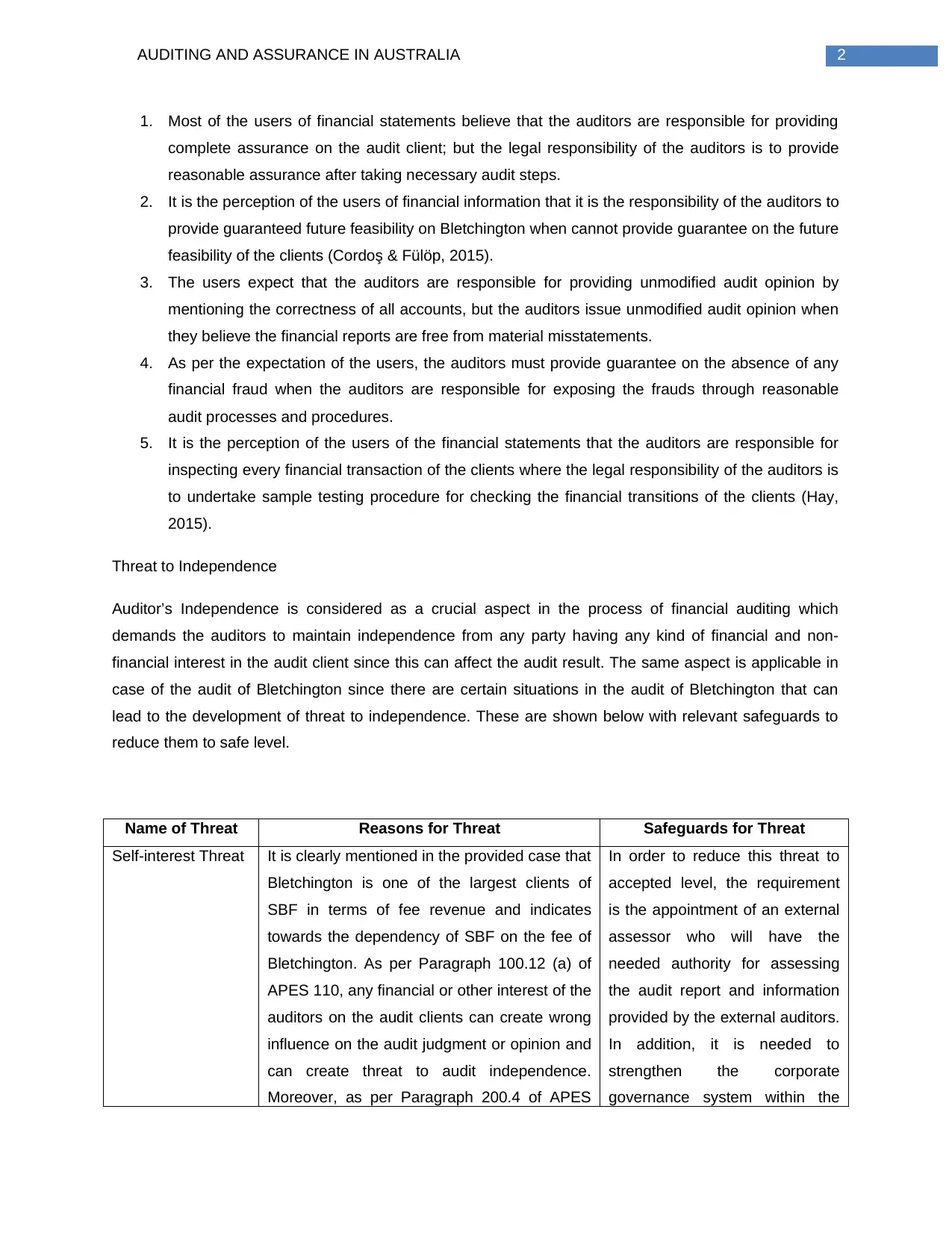
2AUDITING AND ASSURANCE IN AUSTRALIA
1. Most of the users of financial statements believe that the auditors are responsible for providing
complete assurance on the audit client; but the legal responsibility of the auditors is to provide
reasonable assurance after taking necessary audit steps.
2. It is the perception of the users of financial information that it is the responsibility of the auditors to
provide guaranteed future feasibility on Bletchington when cannot provide guarantee on the future
feasibility of the clients (Cordoş & Fülöp, 2015).
3. The users expect that the auditors are responsible for providing unmodified audit opinion by
mentioning the correctness of all accounts, but the auditors issue unmodified audit opinion when
they believe the financial reports are free from material misstatements.
4. As per the expectation of the users, the auditors must provide guarantee on the absence of any
financial fraud when the auditors are responsible for exposing the frauds through reasonable
audit processes and procedures.
5. It is the perception of the users of the financial statements that the auditors are responsible for
inspecting every financial transaction of the clients where the legal responsibility of the auditors is
to undertake sample testing procedure for checking the financial transitions of the clients (Hay,
2015).
Threat to Independence
Auditor’s Independence is considered as a crucial aspect in the process of financial auditing which
demands the auditors to maintain independence from any party having any kind of financial and non-
financial interest in the audit client since this can affect the audit result. The same aspect is applicable in
case of the audit of Bletchington since there are certain situations in the audit of Bletchington that can
lead to the development of threat to independence. These are shown below with relevant safeguards to
reduce them to safe level.
Name of Threat Reasons for Threat Safeguards for Threat
Self-interest Threat It is clearly mentioned in the provided case that
Bletchington is one of the largest clients of
SBF in terms of fee revenue and indicates
towards the dependency of SBF on the fee of
Bletchington. As per Paragraph 100.12 (a) of
APES 110, any financial or other interest of the
auditors on the audit clients can create wrong
influence on the audit judgment or opinion and
can create threat to audit independence.
Moreover, as per Paragraph 200.4 of APES
In order to reduce this threat to
accepted level, the requirement
is the appointment of an external
assessor who will have the
needed authority for assessing
the audit report and information
provided by the external auditors.
In addition, it is needed to
strengthen the corporate
governance system within the
1. Most of the users of financial statements believe that the auditors are responsible for providing
complete assurance on the audit client; but the legal responsibility of the auditors is to provide
reasonable assurance after taking necessary audit steps.
2. It is the perception of the users of financial information that it is the responsibility of the auditors to
provide guaranteed future feasibility on Bletchington when cannot provide guarantee on the future
feasibility of the clients (Cordoş & Fülöp, 2015).
3. The users expect that the auditors are responsible for providing unmodified audit opinion by
mentioning the correctness of all accounts, but the auditors issue unmodified audit opinion when
they believe the financial reports are free from material misstatements.
4. As per the expectation of the users, the auditors must provide guarantee on the absence of any
financial fraud when the auditors are responsible for exposing the frauds through reasonable
audit processes and procedures.
5. It is the perception of the users of the financial statements that the auditors are responsible for
inspecting every financial transaction of the clients where the legal responsibility of the auditors is
to undertake sample testing procedure for checking the financial transitions of the clients (Hay,
2015).
Threat to Independence
Auditor’s Independence is considered as a crucial aspect in the process of financial auditing which
demands the auditors to maintain independence from any party having any kind of financial and non-
financial interest in the audit client since this can affect the audit result. The same aspect is applicable in
case of the audit of Bletchington since there are certain situations in the audit of Bletchington that can
lead to the development of threat to independence. These are shown below with relevant safeguards to
reduce them to safe level.
Name of Threat Reasons for Threat Safeguards for Threat
Self-interest Threat It is clearly mentioned in the provided case that
Bletchington is one of the largest clients of
SBF in terms of fee revenue and indicates
towards the dependency of SBF on the fee of
Bletchington. As per Paragraph 100.12 (a) of
APES 110, any financial or other interest of the
auditors on the audit clients can create wrong
influence on the audit judgment or opinion and
can create threat to audit independence.
Moreover, as per Paragraph 200.4 of APES
In order to reduce this threat to
accepted level, the requirement
is the appointment of an external
assessor who will have the
needed authority for assessing
the audit report and information
provided by the external auditors.
In addition, it is needed to
strengthen the corporate
governance system within the
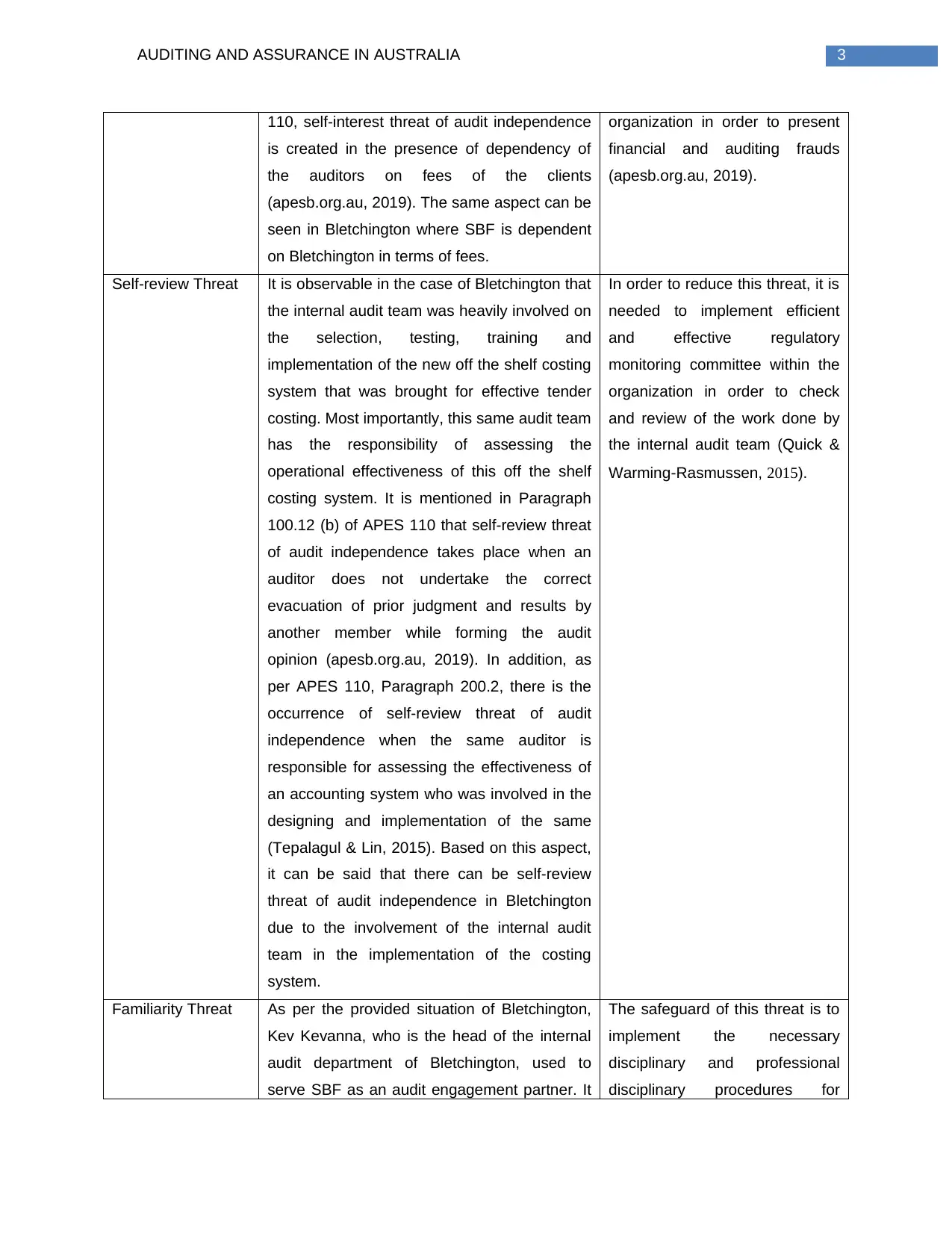
3AUDITING AND ASSURANCE IN AUSTRALIA
110, self-interest threat of audit independence
is created in the presence of dependency of
the auditors on fees of the clients
(apesb.org.au, 2019). The same aspect can be
seen in Bletchington where SBF is dependent
on Bletchington in terms of fees.
organization in order to present
financial and auditing frauds
(apesb.org.au, 2019).
Self-review Threat It is observable in the case of Bletchington that
the internal audit team was heavily involved on
the selection, testing, training and
implementation of the new off the shelf costing
system that was brought for effective tender
costing. Most importantly, this same audit team
has the responsibility of assessing the
operational effectiveness of this off the shelf
costing system. It is mentioned in Paragraph
100.12 (b) of APES 110 that self-review threat
of audit independence takes place when an
auditor does not undertake the correct
evacuation of prior judgment and results by
another member while forming the audit
opinion (apesb.org.au, 2019). In addition, as
per APES 110, Paragraph 200.2, there is the
occurrence of self-review threat of audit
independence when the same auditor is
responsible for assessing the effectiveness of
an accounting system who was involved in the
designing and implementation of the same
(Tepalagul & Lin, 2015). Based on this aspect,
it can be said that there can be self-review
threat of audit independence in Bletchington
due to the involvement of the internal audit
team in the implementation of the costing
system.
In order to reduce this threat, it is
needed to implement efficient
and effective regulatory
monitoring committee within the
organization in order to check
and review of the work done by
the internal audit team (Quick &
Warming‐Rasmussen, 2015).
Familiarity Threat As per the provided situation of Bletchington,
Kev Kevanna, who is the head of the internal
audit department of Bletchington, used to
serve SBF as an audit engagement partner. It
The safeguard of this threat is to
implement the necessary
disciplinary and professional
disciplinary procedures for
110, self-interest threat of audit independence
is created in the presence of dependency of
the auditors on fees of the clients
(apesb.org.au, 2019). The same aspect can be
seen in Bletchington where SBF is dependent
on Bletchington in terms of fees.
organization in order to present
financial and auditing frauds
(apesb.org.au, 2019).
Self-review Threat It is observable in the case of Bletchington that
the internal audit team was heavily involved on
the selection, testing, training and
implementation of the new off the shelf costing
system that was brought for effective tender
costing. Most importantly, this same audit team
has the responsibility of assessing the
operational effectiveness of this off the shelf
costing system. It is mentioned in Paragraph
100.12 (b) of APES 110 that self-review threat
of audit independence takes place when an
auditor does not undertake the correct
evacuation of prior judgment and results by
another member while forming the audit
opinion (apesb.org.au, 2019). In addition, as
per APES 110, Paragraph 200.2, there is the
occurrence of self-review threat of audit
independence when the same auditor is
responsible for assessing the effectiveness of
an accounting system who was involved in the
designing and implementation of the same
(Tepalagul & Lin, 2015). Based on this aspect,
it can be said that there can be self-review
threat of audit independence in Bletchington
due to the involvement of the internal audit
team in the implementation of the costing
system.
In order to reduce this threat, it is
needed to implement efficient
and effective regulatory
monitoring committee within the
organization in order to check
and review of the work done by
the internal audit team (Quick &
Warming‐Rasmussen, 2015).
Familiarity Threat As per the provided situation of Bletchington,
Kev Kevanna, who is the head of the internal
audit department of Bletchington, used to
serve SBF as an audit engagement partner. It
The safeguard of this threat is to
implement the necessary
disciplinary and professional
disciplinary procedures for
Secure Best Marks with AI Grader
Need help grading? Try our AI Grader for instant feedback on your assignments.
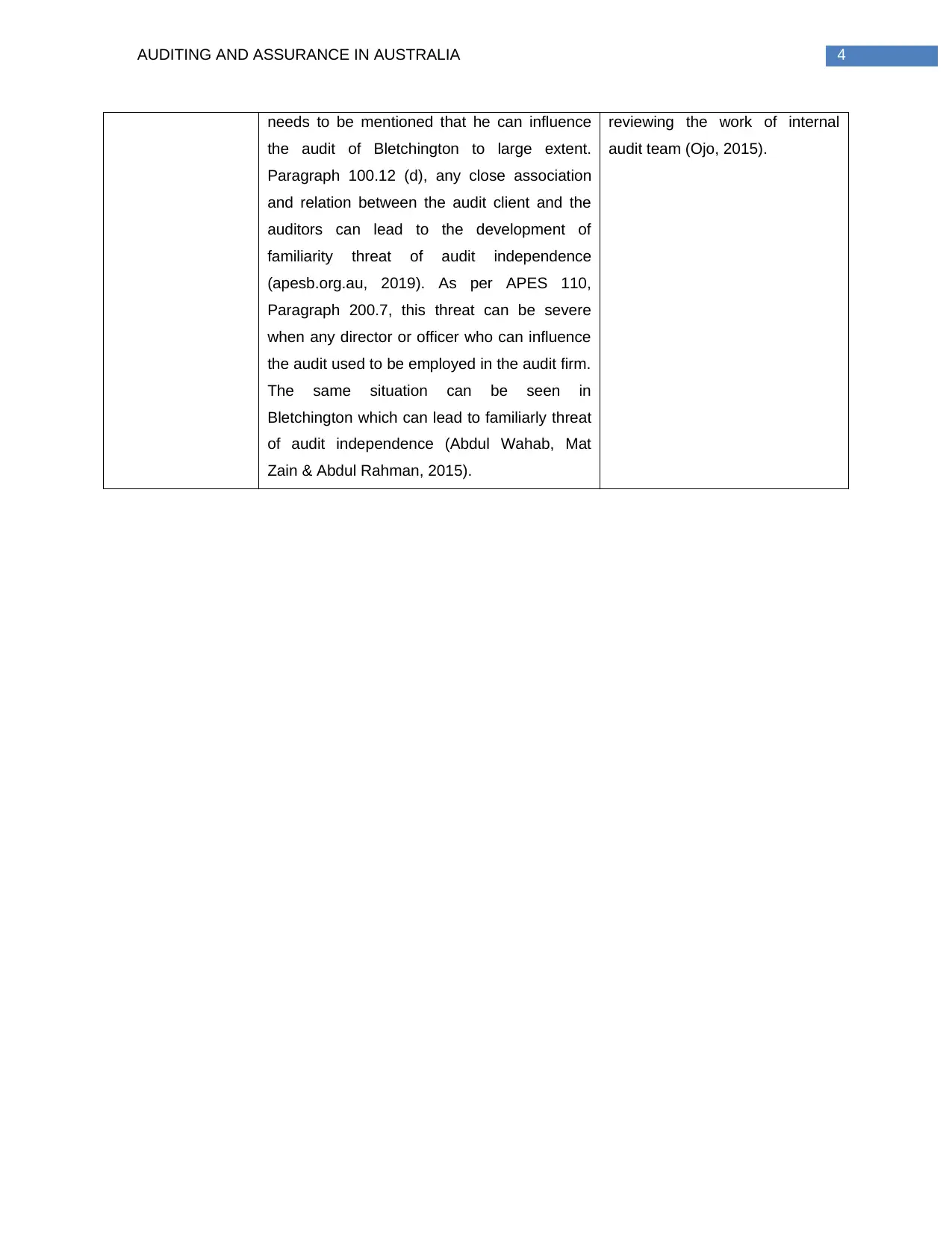
4AUDITING AND ASSURANCE IN AUSTRALIA
needs to be mentioned that he can influence
the audit of Bletchington to large extent.
Paragraph 100.12 (d), any close association
and relation between the audit client and the
auditors can lead to the development of
familiarity threat of audit independence
(apesb.org.au, 2019). As per APES 110,
Paragraph 200.7, this threat can be severe
when any director or officer who can influence
the audit used to be employed in the audit firm.
The same situation can be seen in
Bletchington which can lead to familiarly threat
of audit independence (Abdul Wahab, Mat
Zain & Abdul Rahman, 2015).
reviewing the work of internal
audit team (Ojo, 2015).
needs to be mentioned that he can influence
the audit of Bletchington to large extent.
Paragraph 100.12 (d), any close association
and relation between the audit client and the
auditors can lead to the development of
familiarity threat of audit independence
(apesb.org.au, 2019). As per APES 110,
Paragraph 200.7, this threat can be severe
when any director or officer who can influence
the audit used to be employed in the audit firm.
The same situation can be seen in
Bletchington which can lead to familiarly threat
of audit independence (Abdul Wahab, Mat
Zain & Abdul Rahman, 2015).
reviewing the work of internal
audit team (Ojo, 2015).
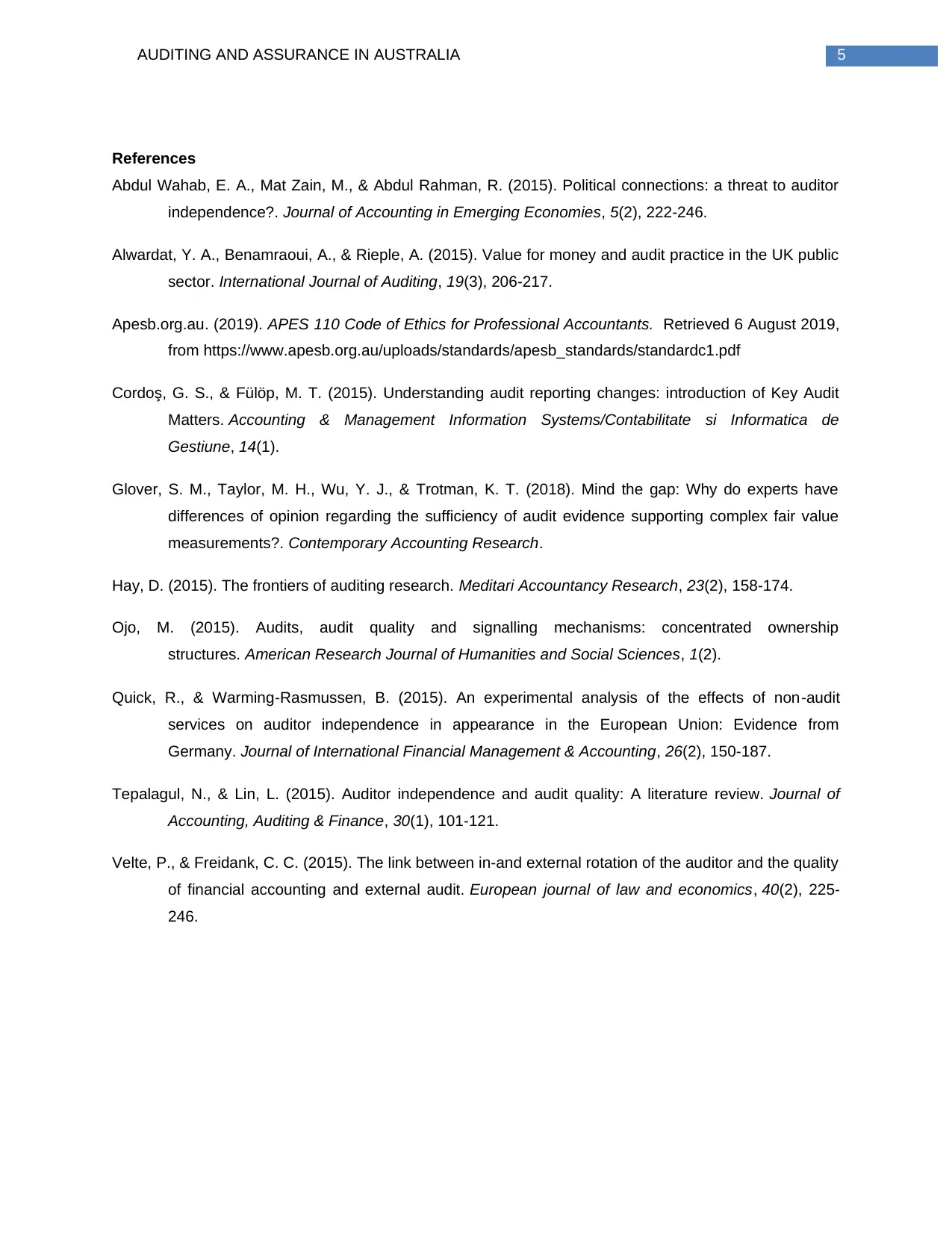
5AUDITING AND ASSURANCE IN AUSTRALIA
References
Abdul Wahab, E. A., Mat Zain, M., & Abdul Rahman, R. (2015). Political connections: a threat to auditor
independence?. Journal of Accounting in Emerging Economies, 5(2), 222-246.
Alwardat, Y. A., Benamraoui, A., & Rieple, A. (2015). Value for money and audit practice in the UK public
sector. International Journal of Auditing, 19(3), 206-217.
Apesb.org.au. (2019). APES 110 Code of Ethics for Professional Accountants. Retrieved 6 August 2019,
from https://www.apesb.org.au/uploads/standards/apesb_standards/standardc1.pdf
Cordoş, G. S., & Fülöp, M. T. (2015). Understanding audit reporting changes: introduction of Key Audit
Matters. Accounting & Management Information Systems/Contabilitate si Informatica de
Gestiune, 14(1).
Glover, S. M., Taylor, M. H., Wu, Y. J., & Trotman, K. T. (2018). Mind the gap: Why do experts have
differences of opinion regarding the sufficiency of audit evidence supporting complex fair value
measurements?. Contemporary Accounting Research.
Hay, D. (2015). The frontiers of auditing research. Meditari Accountancy Research, 23(2), 158-174.
Ojo, M. (2015). Audits, audit quality and signalling mechanisms: concentrated ownership
structures. American Research Journal of Humanities and Social Sciences, 1(2).
Quick, R., & Warming‐Rasmussen, B. (2015). An experimental analysis of the effects of non‐audit
services on auditor independence in appearance in the European Union: Evidence from
Germany. Journal of International Financial Management & Accounting, 26(2), 150-187.
Tepalagul, N., & Lin, L. (2015). Auditor independence and audit quality: A literature review. Journal of
Accounting, Auditing & Finance, 30(1), 101-121.
Velte, P., & Freidank, C. C. (2015). The link between in-and external rotation of the auditor and the quality
of financial accounting and external audit. European journal of law and economics, 40(2), 225-
246.
References
Abdul Wahab, E. A., Mat Zain, M., & Abdul Rahman, R. (2015). Political connections: a threat to auditor
independence?. Journal of Accounting in Emerging Economies, 5(2), 222-246.
Alwardat, Y. A., Benamraoui, A., & Rieple, A. (2015). Value for money and audit practice in the UK public
sector. International Journal of Auditing, 19(3), 206-217.
Apesb.org.au. (2019). APES 110 Code of Ethics for Professional Accountants. Retrieved 6 August 2019,
from https://www.apesb.org.au/uploads/standards/apesb_standards/standardc1.pdf
Cordoş, G. S., & Fülöp, M. T. (2015). Understanding audit reporting changes: introduction of Key Audit
Matters. Accounting & Management Information Systems/Contabilitate si Informatica de
Gestiune, 14(1).
Glover, S. M., Taylor, M. H., Wu, Y. J., & Trotman, K. T. (2018). Mind the gap: Why do experts have
differences of opinion regarding the sufficiency of audit evidence supporting complex fair value
measurements?. Contemporary Accounting Research.
Hay, D. (2015). The frontiers of auditing research. Meditari Accountancy Research, 23(2), 158-174.
Ojo, M. (2015). Audits, audit quality and signalling mechanisms: concentrated ownership
structures. American Research Journal of Humanities and Social Sciences, 1(2).
Quick, R., & Warming‐Rasmussen, B. (2015). An experimental analysis of the effects of non‐audit
services on auditor independence in appearance in the European Union: Evidence from
Germany. Journal of International Financial Management & Accounting, 26(2), 150-187.
Tepalagul, N., & Lin, L. (2015). Auditor independence and audit quality: A literature review. Journal of
Accounting, Auditing & Finance, 30(1), 101-121.
Velte, P., & Freidank, C. C. (2015). The link between in-and external rotation of the auditor and the quality
of financial accounting and external audit. European journal of law and economics, 40(2), 225-
246.
1 out of 6
Related Documents
Your All-in-One AI-Powered Toolkit for Academic Success.
+13062052269
info@desklib.com
Available 24*7 on WhatsApp / Email
![[object Object]](/_next/static/media/star-bottom.7253800d.svg)
Unlock your academic potential
© 2024 | Zucol Services PVT LTD | All rights reserved.





